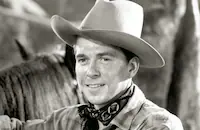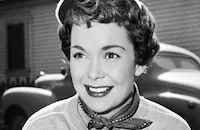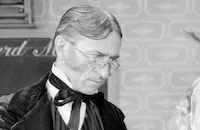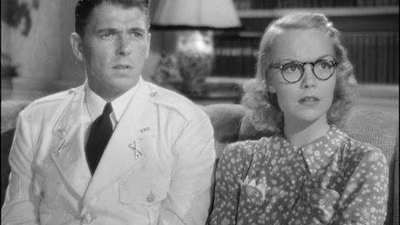Brother Rat

Brief Synopsis
Cast & Crew
William Keighley
Priscilla Lane
Wayne Morris
Johnnie Davis
Jane Bryan
Eddie Albert
Film Details
Technical Specs

Synopsis
Billy Randolph, Dan Crawford, and Bing Edwards are roommates at the Virginia Military Institute, known as the West Point of the South. Billy is in love with Joyce Winfree, who has brought her college friend, Claire Adams, along for the big baseball weekend before graduation. Bing arrives at Joyce's house in anxious anticipation of meeting Kate Rice. Kate, to whom Bing is secretly married, shocks him with the news that she is pregnant and is leaving town to have the baby. Bing is so preoccupied by the news that he wanders off the field during garrison review to coo at a baby on the sidelines. Joyce and Billy set Dan up with Claire, a plain, studious woman, who, unknown to the men, is the daughter of the Commandant, Colonel Ramm. Arriving to pick up his daughter, Ramm catches Billy out after hours and Billy has to admit that Dan was with him. The two men are confined to quarters, which means that Dan, one of the team's star players, is out of the game. The other star player, Bing, is too upset over Kate to be any good. His friends try to raise funds for Bing's baby by pawning a saber for money to bet on the game. Unfortunately, Ramm thinks that Bing did it himself, and he is confined to quarters as well. This gives Bing a chance to cram for his science exams, aided by Claire. Dan discovers that Claire is beautiful without her glasses and Bing passes his exam, but fails to win the athletic association award. When he gets a telegram announcing the birth of a boy, the men remember that there is a reward for the first baby born to one of their class members. His money worries over, Bing proudly hands the Commandant a cigar at commencement.

Director

William Keighley
Cast

Priscilla Lane

Wayne Morris
Johnnie Davis

Jane Bryan

Eddie Albert

Ronald Reagan

Jane Wyman

Henry O'neill

Gordon Oliver

Larry Williams
William Tracey
Jessie Busley

Olin Howland

Louise Beavers
Isabel Withers
Robert Scott
Fred Hamilton
Oscar G. Hendrian
Frank Coghlan Jr.
Jerry Cecil
Howard Leeds
Hugh Mcarthur
Tommy Seidel
Jerry Fletcher

George O'hanlon
Cliff Saum

Don Defore

Wilfrid Lucas
Mildred Gover
William Orr
Allan Cavan
Crew
George Abbott
Milo Anderson
Leo F. Forbstein
Oliver S. Garretson
Ernie Haller
Chuck Hansen
William Holmes
Robert Lord
Richard Macaulay
Frank Mccarthy
Max Parker
Carrol Sax
Jerry Wald
Jack L. Warner

Videos
Movie Clip




Trailer
Hosted Intro
Film Details
Technical Specs

Articles
Brother Rat
Born Bert DeWayne Morris, Jr., the Los Angeles native was scouted from the ranks of the Pasadena Playhouse. Prior to Brother Rat (1939), he had appeared in more than a dozen films and was Hollywood's original Kid Galahad (1937). Morris served with honor as a Navy pilot in the Second World War but the interruption was disastrous for his career; because Warners refused to loan him out to producer Mark Hellinger, Morris lost out on the lead in Robert Siodmak's The Killers (1946) to Burt Lancaster. Shortly before his death from a heart attack at age 45, Morris made a memorable appearance in Stanley Kubrick's searing anti-war film Paths of Glory (1957).
Charged with helming Brother Rat was William Keighley. A native of Pennsylvania who had honed his directing chops on Broadway, Keighley was known for the vigor of such Warners crime pictures as 'G'Men (1935) with James Cagney and Bullets or Ballots (1936) with Edward G. Robinson and Humphrey Bogart. Entrusted with the lavish, Technicolor The Adventures of Robin Hood (1938) starring Errol Flynn, Keighley found himself replaced after a couple of weeks by Michael Curtiz when the Warners brass felt he was taking too long to get his footage. Despite comporting himself with an affected, Mid-Atlantic air, Keighley was an inveterate practical joker. When technical advisor Frank McCarthy (a former classmate of Monks and Finklehoffe and an ex-VMI instructor) arrived on set, he was greeted with the irreverent spectacle of Keighley's cast of mock-cadets wearing their caps backwards and pitching pennies into the cannon pedestal of Stonewall Jackson's statue. However tame by contemporary standards, the stunt would have scandalized "the West Point of the Confederacy." No record was kept of McCarthy's reaction.
Frank McCarthy makes a cameo appearance in Brother Rat, instructing leading lady Priscilla Lane how to handle a saber. (Lane came to the production late, replacing original actress Susan Hayward on the caprice of studio head Jack L. Warner.) McCarthy's involvement with Hollywood was more than passing. He had left VMI with the goal of breaking into show business and used his influence to secure work as a press agent for George Abbott. With the outbreak of war in 1941, McCarthy reenlisted, becoming an aid to General George C. Marshall and attaining the rank of major by the age of thirty. McCarthy was being groomed for a cabinet position in the Truman administration when he abruptly withdrew his name from consideration due to an undefined "illness." Not commonly known at the time but understood in certain circles was that McCarthy was a closeted homosexual whose long-time partner was publicist Rupert Allan. Although he had the protection of powerful friends (ex-boss George Marshall had lobbied powerfully to end the prosecution of gay servicemen and FBI director J. Edgar Hoover's dossier on him contained no powder keg data), McCarthy's retirement may have been an act of political self-sacrifice. He returned to Hollywood and worked as the head of public relations for Fox, acting as an in-house censor trouble-shooting problematic material during production. As a producer, McCarthy shepherded the Academy Award® winning Patton (1970) to the big screen and even accepted George C. Scott's Best Actor Oscar® at the 1971 ceremony.
In his reduced status, Eddie Albert was teamed with another rising star Ronald Reagan. "Dutch" Reagan had been a Des Moines sportscaster who came west to cover the Chicago Cubs' spring training on Catalina Island. Through more than six degrees of separation, Reagan used his contacts to obtain a screen test at Warners and had the offer of a seven-year contract before he got home to Iowa.
For Brother Rat, Reagan was paired with Jane Wyman, whose bespectacled bookworm was the perfect foil for Reagan's rambunctious "Dan Crawford" (a role originated by José Ferrer). Reagan and Wyman had met on the Warners lot while posing for publicity photos. Despite the fact that he was a sun-worshipping jock and she a club-hopping party girl (and despite the ticklish fact that both were involved with other people), a mutual attraction smoldered between them.
During production of Brother Rat on the grounds of the San Diego Military Academy (subbing for VMI), Wyman separated from her older husband, New Orleans dress manufacturer Myron Futterman, and was divorced within weeks of the film's October 1948 opening. Reagan proposed to Wyman on the set of the sequel, Brother Rat and a Baby (1940), and gossip columnist Louella Parsons hosted their wedding reception on January 26, 1940. The Reagan-Wyman union lasted only eight years but Reagan was made an honorary Brother Rat at Virginia Military Institute and later had some success in politics.
Producer: George Abbott, Robert Lord, Hal B. Wallis, Jack L. Warner
Director: William Keighley
Screenplay: Richard Macaulay, Jerry Wald, Fred Finklehoff (play), John Monks Jr (play)
Cinematography: Ernest Haller
Film Editing: William Holmes
Art Direction: Max Parker
Music: Heinz Roemheld
Cast: Priscilla Lane (Joyce Winfree), Wayne Morris (Billy Randolph), Johnnie Davis (A. Furman Townsend Jr.), Jane Bryan (Kate Rice), Eddie Albert (Bing Edwards), Ronald Reagan (Dan Crawford).
BW-90m. Closed captioning.
by Richard Harland Smith

Brother Rat
Eddie Albert (1906-2005)
The son of a real estate agent, Albert was born Edward Albert Heimberger in Rock Island, Ill., on April 22, 1906. His family relocated to Minneapolis when he was still an infant. Long entralled by theatre, he studied drama at the University of Minnesota. After years of developing his acting chops in touring companies, summer stock and a stint with a Mexican circus, he signed a contract with Warner Bros. and made his film debut in Brother Rat (1938). Although hardly a stellar early film career, he made some pleasant B-pictures, playing slap happy youths in Brother Rat and a Baby (1940), and The Wagons Roll at Night (1941).
His career was interrupted for military service for World War II, and after his stint (1942-45), he came back and developed a stronger, more mature screen image: Smash-Up: The Story of a Woman (1947); Carrie (1952); his Oscar® nominated turn as the Bohemian photographer friend of Gregory Peck in Roman Holiday (1953); a charming Ali Hakim in Oklahoma (1955); and to many critics, his finest hour as an actor, when he was cast unnervingly against type as a cowardly military officer whose lack of commitment to his troops results in their deaths in Attack! (1956).
As he settled into middle-age, Albert discovered belated fame when he made the move to Hooterville. For six seasons (1965-71), television viewers loved Eddie Albert as Oliver Wendal Douglas, the bemused city slicker who, along with his charming wife Lisa (Eva Gabor), takes a chance on buying a farm in the country and dealing with all the strange characters that come along their way. Of course, I'm talking about Green Acres. If he did nothing else, Alberts proved he could be a stalwart straight man in the most inane situations, and pull it off with grace.
After the run of Green Acres, Albert found two of his best roles in the late stages of his career that once again cast him against his genial, good-natured persona: the fiercly overprotective father of Cybill Shepherd in The Heartbreak Kid (1972), for which he earned his second Oscar® nomination; and the sadistic warden in Robert Aldrich's raucous gridiron comedy The Longest Yard (1974). Soon, Albert was in demand again, and he had another hit series, playing a retired police officer who partners with a retired con artist (Robert Wagner) to form a detective agency in Switch (1975-78).
The good roles slowed down slightly by the dawn of the '80s, both film: The Concorde: Airport '79 (1979), How to Beat the High Co$t of Living (1980), Take This Job and Shove It (1981); and television: Highway to Heaven, Murder, She Wrote, Thirtysomething, offered him little in the way of expansion. Yet, Albert spent his golden years in a most admirable fashion, he became something of activist for world health and pollution issues throughout the latter stages of his life. It is widely acknowledged that International Earth Day (April 22) is honored on his birthday for his tireless work on environemental matters. Albert was married to famed hispanic actress Margo (1945-85) until her death, and is survived by his son, actor Edward Albert, a daughter, and two granddaughters.
by Michael T. Toole
Eddie Albert (1906-2005)
Ronald Reagan, 1911-2004 - TCM Remembers Ronald Reagan
Ronald Reagan, the actor turned elected official whose fascinating career saw him develop as a contract player for Warner Brothers studios, to a politician who fulfilled his ambitions by becoming the 40th President of the United States, died at his home in Los Angeles on June 5 after a long battle with Alzheimer's disease. He was 93.
He was born Ronald Wilson Reagan on February 6, 1911 in Tampico, Illinois to John and Nelle Reagan. When Reagan was nine, his family settled down in the small community of Dixon, about 100 miles west of Chicago. After high school, Reagan enrolled in Eureka College, a small Christian school near Peoria. He graduated in 1932 with a degree in Economics, and pursued a career in broadcasting. His first gig was as a part-time announcer at WOC in Davenport, Iowa. Within a year, WOC had merged with its big-sister station, WHO in Des Moines, and Reagan was hired as a sports announcer.
In the spring of 1937, Reagan drove to Southern California to catch the Chicago Cubs in spring training on Santa Catalina Island. While he was in California, he wrangled a screen test and signed a contract for $200 a week with Warner Brothers. His film debut was rather inauspicious; he portrayed a radio announcer in an innocuous comedy Love is on the Air (1937). He made a few more "B" programmers like Hollywood Hotel (also 1937), and Girls on Probation (1938), before getting his first prominent role opposite Bette Davis in the popular tearjerker, Dark Victory (1939).
Although he seldom got credit for being a good actor, there was no denying that Reagan held his own given the right material: Knute Rockne, All American as the doomed Notre Dame football hero George "The Gipper" Gipp, where he delivered the film's immortal line "Win one for the Gipper!"; Santa Fe Trail in which he ably supports Errol Flynn in one of the boxoffice hits of its era (both 1940); Kings Row (1941), featuring one of his finest performances as a small-town playboy whose legs are amputated by a careless surgeon; and Desperate Journey (1942) where he again supported Flynn in an exciting action picture.
Due to his poor eyesight, Reagan didn't see any action in World War II, so the studio heads assigned him to star in a series of patriotic films produced by the First Motion Picture Unit of the Army Air Forces in Culver City. Between 1942-45, Reagan starred in over 400 of these films. After the war, Reagan still found some good roles: The Voice of the Turtle (1947) proved he had a deft hand at light comedy opposite Eleanor Parker; The Hasty Heart (1949) offered another underrated performance as he ably portrayed the Yank in John Patrick's much heralded wartime play; and Storm Warning (1950) was a slick melodrama that cast Reagan as a crusading District Attorney determined to bring the KKK in a small southern town, with the help of Doris Day and Ginger Rogers!
It was around this time that Reagan became involved in politics. In 1947, he began a five-year term as president of the Screen Actors Guild (SAG), and testified in October of that year before the newly formed House Un-American Activities Committee (HUAC). He identified suspected Communists Larry Parks, Howard Da Silva and Alexander Knox, all of whom were subsequently called to testify, and subsequently blacklisted. Later records showed Reagan was so concerned about the Communist influence in Hollywood, that he became an FBI informer.
As Reagan became steeped in his political career, his parts throughout the '50s became inferior: the notorious Bedtime for Bonzo (1951); the coy "sex" comedy She's Working Her Way Through College (1952) that cast him as a college professor who romances a stripper! (Virginia Mayo); Cattle Queen of Montana (1955), a sluggish Western that even the redoubtable Barbara Stanwyck couldn't save; and finally Hellcats of the Navy (1957), a stodgy war picture that would be his only film that co-starred his wife Nancy (Davis).
Television offered some salvation. For eight years, (1954-62), Reagan served as the host of General Electric Theater, a televised series of dramas. He also found a niche as GE's goodwill ambassador to employees and to civic and business groups around the country, furthering his taste and honing his craft as a public official. By the mid '60s, Reagan would move into politics entirely, save for one last film, the thrilling The Killers (1964), Reagan's only known villainous role, as a murderous gangster. That same year, he actively campaigned for Republican Presidential candidate Barry Goldwater, although Goldwater lost to Lyndon B. Johnson.
Reagan whose profile was riding high, had cemented his future as a successful politician. In 1966, he ran against incumbent Governor Pat Brown for the state of California and won, serving successfully for two terms until 1974.
Reagan began an all-out, two-year drive to wrest the 1976 nomination from incumbent Gerald R. Ford, an appointed vice president who became president on the resignation of Nixon. Reagan fell short by a handful of delegates to the Republican national convention. But Ford lost to Jimmy Carter, and Reagan became the front-runner to challenge Carter in 1980. After defeating Carter, Reagan held two terms as President of the United States (1981-89). After his second term was over, he retired quietly in California. In 1994, it was revealed to the media that Reagan was suffering from Alzheimer's disease; he had been kept out of the public eye since then.
He was married briefly to actress Jane Wyman (1940-48), and had two children; a daughter Maureen and an adopted son, Michael. In 1952, he married a budding film starlet, Nancy Davis, who bore him two more children; a daughter, Patty; and a son, Ronald Jr. Ronald Reagan is survived by Nancy, Michael, Patty and Ron Jr. His daughter Maureen died of Melanoma in 2001 at the age of 60.
by Michael T. Toole
Ronald Reagan, 1911-2004 - TCM Remembers Ronald Reagan
Quotes
Trivia
After the filming of this picture 'Reagan, Ronald' was made an honorary "Brother Rat" at Virginia Military Institute.
Notes
Playwrights John Monks, Jr. and Fred Finklehoffe were former students at the Virginia Military Institute. The play had its premiere at the State Theater in Lexington, VA, home of VMI, and was a box office success. George Abbott presented the play on Broadway with Warner Bros.' backing. Eddie Albert (1906-2005), who made his film debut in Brother Rat, was the only holdover from the Broadway production to act in the movie, but William Tracey had previously played Misto Bottome in the West Coast stage production. Monks and Finklehoffe went on to careers as screenwriters. According to modern sources, Monks wrote, directed and starred in the documentary film We Are the Marines (Fox, 1942). Ronald Reagan and Jane Wyman were married between 1940 and 1948. Warner Bros. made a sequel Brother Rat and a Baby in 1940 (see below) and a 1952 musical remake About Face starred Gordon MacRae, Eddie Bracken, Dick Wesson, Phyllis Kirk and Joel Grey.

Miscellaneous Notes
Released in United States Fall October 29, 1938
Released in United States Fall October 29, 1938















